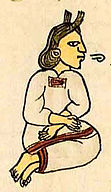I’m honored to present a guest post from MXocoyotzin, an historian, musician, and a freethinker. He speaks a good Nahuatl, loves rock, literature and poetry, admits to being a chocoholic and a devoted fan of Beatles and AC/DC.
He is also one of the founders of In Tlilli In Tlapalli – pre-hispanic blog where you can read many more fascinating articles by him, and other knowledgeable, well-versed in history people.
For the original post and more information, you are invited to visit In Tlilli In Tlapalli – pre-hispanic blogWomen in Mesoamerican societies
In Mesoamerican society women played a very important role, not only among the Mexica (Aztecs), but among the other Nahua cultures as well. At various times, from Preclassic to Postclassic times there is much evidence that let us learn about a woman’s place in the Mexican Valley and beyond it.

Like in most societies, the dominance of the men was evident, with Mesoamerica being no exception. From the moment of birth this was already clear that a baby-boy was received with a little more ‘cheerful’ welcome (although the boys were informed that they came to the world to work). Baby-girls were greeted with words that encouraged them to stay at home. This was refuted by the ritual of burying the umbilical cord in the floor to symbolize the unity of the house (although if the girl was born to a noble family, this part of the ritual was made difficult since the houses of the nobles had no earthen floors).
The words that were said to the newborn were: “… Is no gait out of house, you do not have to have habit of going nowhere. You have to be the ash with which the fire is covered in this hearth. You have to be the trivet where it puts itself on the pan. In this place our master Yoaltecuhtli buries you. Here you have to work, your mission has to be bringing water and grinding corn in put you… “

Like boys, girls were required to attend school, a sort of calmecac or tepochcalli, for various periods of times, depending on a girl’s belonging to a noble or a commoner family.
In the case of a girl who was not noble, the training in the household chores began at the age of 4 up to 12. She had been trained in all aspects of housework. To avoid idleness, the girls were put to sweep the house and the street. This had been done as much for the cleanliness as for honoring Yoalticitl. At the age of 13, after the girl had learned to spin, she had been taught to make tortillas and prepare food, although her main task remained to weave cotton.
In addition to this, noble girls were taught the art of speaking and walking with great dignity. When older, they were taught, among other things, to conduct rituals and supervise the religious aspects of life, to learn how to say prayers and how to prepare offerings to the gods, helping to protect their husbands and families.

The noblewomen, pillis, had to keep the home clean and do daily offerings with rubber, copal (resin) and food that were placed on their home altars. Less occupied with other activities, such as cooking and weaving, most of the noblewomen were entrusted withthe administration of home economics.
For Mesoamerican society, virginity was a very important factor, because when a woman lost hers before the marriage, she was less likely to be accepted by a man, because this way he would have lose his honor. So parents would usually make sure their daughters were kept well until marriage.
A woman in most Nahua societies was physically and mentally prepared for a marriage by the age of 18, but neither they nor their families were the ones to look for a husband. These were men (and man’s family) who would seek the woman out. Sometimes a matchmaker, cihuatlanque, would be employed.
A woman was expected to be loyal and respectful to her husband. The husbands, on the other hand (provided he was noble) could have multiple wives. The trial for infidelity was a public affair and the men were required to take their wives and daughters (no matter how small they were) to witness the punishment, so that the women should learn not to do this.

In conclusion, this is principally what a woman was representing in the pre-Hispanic world, entrusted with the education of her children, praying for her husband, maintaining order in the house, and making sure it was functioning properly. And although it shows a sad difference between the genders , women did not receive a degree of scorn or contempt. Instead, they were a huge pillar of Mesoamerican society, not only socially but religiously as well. Even the deities had their concept of male-female duality, which can be seen from the main deities such as Ometecuhtli and Omecihuatl.
Women were especially revered for being the givers of life, and when they lost this virtue with age, they were not belittled, but on the contrary – they were more appreciated because they had all the wisdom within.
as always! another informative post you have here. thank you Zoe!